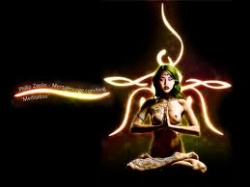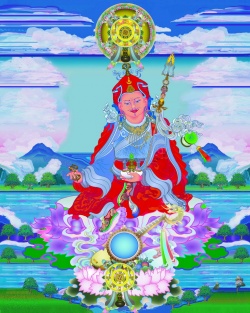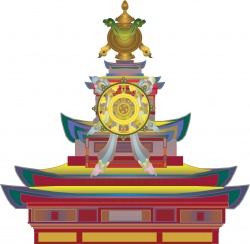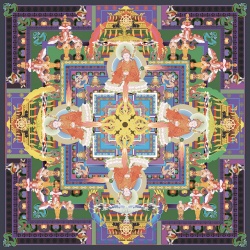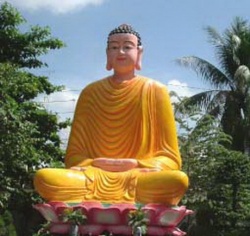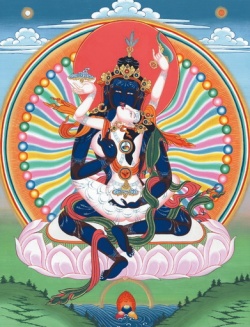Kami
The names of Japanese kami are notorious for their numerous variations. In the online EOA, headings of articles dealing with individual kami adopt a typical name style, and all other modifications and variations of the name are listed as "other names." The common title of kami, ōkami or mikoto frequently found appended to names has also been omitted from the entry headings here.
The names of many kami begin with the honorific prefix Ame no ("Heavenly"), which is frequently also read Ama no. To reduce space, a single reading has been provided in the headings here. As a result, readers unable to find a specific kami name which they believe begins with Ama no should also search under Ame no (and vice versa). For example, the [[kami}} listed here as Amenokagami may be found listed in some sources as Amanokagami, but the former name is used exclusively in the EOS.
Italicized works following entry headings for kami names indicates the major classical sources for the kami name involved (Nihon shoki is in some cases abbreviated as Nihongi).
At the heart of very early Japanese religious practices are kami. The word is usually translated into English as “gods” or “deities,” though the concept is actually more complicated than that.
Kami can be divided into two main categories. The first relates to natural phenomena. For example, a mountain or a stream may be thought to have a kami associated with it. A mountain kami might be seen to help a farmer by providing water during the growing season. This kind of
spirit or force does not necessarily serve humans, but its favor can be beneficial to them. The opposite is also true—an angry kami can cause great destruction.
The second category of kami are ancestral spirits, called ujikami, or clan deities. These spirits can help individuals in the present. However, they do much more than that. The process of honoring one’s ancestors helps unify the extended family that descended
from them. Maintaining these bonds strengthens the clan and the entire society. A person is responsible to these spirits for his or her behavior. If a person does something dishonorable, such as committing a crime or telling a lie, the ancestors are shamed as well.
The structure of society—with leaders or king at the top and “regular people” at the bottom—was also reflected in the kami structure. The more powerful kami could help an entire village or area.
No kami is all-powerful or flawless. Often in Japanese myths, the ujikami do things that a human might, getting into trouble or upsetting others. In this way, they are like Greek or Roman gods.
In early Japan, shrines to the kami were generally not very elaborate, nor were most prayers or rituals addressing them. Those in charge of the local government were also in charge of maintaining shrines and conducting the rituals honoring the important clan ancestors.
Religion and government were, therefore, intertwined in the social structure. Ancestral kami shrines were kept by certain members of the clan entitled or allowed to do so. But anyone could pray to a kami, whether the deity was an ancestral god or one connected with a natural
phenomenon. Shamans, who could communicate with kami and use supernatural power to cure people, were an important part of early Shinto practices. The majority of these shamans were women. Certain families passed on the role of shaman from generation to generation. They had special procedures and rituals for contacting the dead as well as invoking the gods.
Ancient Japanese history states that there are 8 million kami, using a phrase that means “eight hundred times ten thousand,” in the same way we might say “countless” or “millions and millions.” While the figure may not have been meant literally, there are more kami than anyone can count. It is
not an exaggeration to say that every village had its own special god forces and spirits that protected it. Every family venerated its
ancestors. And stories or myths of those who had gone before were an important way for the families not only to remember the past but to show their place in the present.
Kami (かみ in Hiragana) (神 ?) are the spirits or phenomena that are worshipped in the religion of Shinto. They are elements in nature, animals, creationary forces in the universe, as well as spirits of the revered deceased. Many Kami are considered the
ancient ancestors of entire clans, and some ancestors became Kami upon their death if they were able to embody the values and virtues of Kami in life. Traditionally great or charismatic leaders like the Emperor could be kami. In Shinto,
Kami are not separate from nature, but are of nature, possessing positive and negative, good and evil characteristics. They are manifestations of Musubi (結び), the interconnecting energy of the universe, and are considered exemplary of what humanity should s
trive towards. Kami are believed to be “hidden” from this world, and inhabit a complementary existence that mirrors our own, shinkai (the world of the Kami). To be in harmony with the awe inspiring aspects of nature is to be conscious of Kannagara [the way of the Kami) (随神の道 or 惟神の道). Though the word Kami is translated in multiple ways, no one definition expresses its full meaning. In this way, the ambiguity of the meaning of Kami is necessary, as it conveys the ambiguous nature of Kami themselves. As Shinto is an inclusive religion, Kami has been expanded to include Buddhas and the Judeo-Christian God.
Etymology
Kami is the Japanese word for a god, deity, divinity, or spirit (精神). It has been used to describe "mind"(心霊),"God" (ゴッド),"supreme being"(至上者),"one of the Shinto deities", an effigy, a principle and anything that is worshipped. Though "
god" or "deity" is the common interpretation of Kami, some Shinto scholars argue that such a translation can cause a {
{Wiki|misunderstanding}} of the term. The wide variety of usage of the word can be compared to the Sanskrit Deva and the Hebrew Elohim, which also refer to God, gods, angels or spirits.
In some instances, such as Izanagi-no-Mikoto and Izanami-no-Mikoto, Kami are personified deities, similar to the gods of ancient Greece or
Rome. In other cases, such as those concerning the phenomenon of natural emanation, Kami are the spirits dwelling in trees, or forces of nature.
Some etymological suggestions are:
Kami may, at its root, simply mean "spirit", or an aspect of spirituality. It is written with the kanji "神", Sino-Japanese reading
shin or jin; in Chinese, the character is used to refer to various nature spirits of traditional Chinese religion, but not to the Taoist deities or the Supreme Being.
An apparently cognate form, perhaps a loanword, occurs in the Ainu language as kamuy and refers to an animistic concept very similar to Japanese Kami.
Following the discovery of the Jōdai Tokushu Kanazukai it is now known that the medieval word Kami (上) meaning "above" is a false cognate with the modern Kami (Buk Lao), and the etymology of "heavenly beings" is therefore incorrect.
In his Kojiki-den, Motoori Norinaga gave a definition of Kami: "...any being whatsoever which possesses some eminent quality out of the ordinary, and is awe-inspiring, is called Kami."
Because Japanese does not normally distinguish grammatical number in nouns, it is sometimes unclear whether Kami refers to a single or
multiple entities. When a singular concept is needed, "-kami" (神?) or "-kamisama" (神様?) is used as a suffix. The term generally used to refer to multiple Kami is Kamigami.
Gender is also not implied in the word Kami, and as such it can be used to reference either male or female. The word "megami" (女神?), the use of female Kami is a fairly new tradition.
History
While Shinto has no founder, no overarching doctrine, and no religious texts, the Kojiki (the Ancient Chronicles of Japan),
written in 712 CE, and the Nihonshoki (Chronicles of Japan), written in 720 CE, contain the earliest record of Japanese creation myths. The Kojiki also includes descriptions of various Kami.
In the ancient Shinto traditions there were 5 defining characteristics of Kami.
Kami are of two minds. They can nurture and love when respected, or they can cause destruction and disharmony when disregarded. Kami must be appeased in order to gain their favor and avoid their wrath. Traditionally, Kami possess two souls, one gentle (nigi-mitama) and the
other assertive (ara-mitama); additionally in Yamakage Shinto kami have two additional souls that are hidden, one happy (sachi-mitama) and one mysterious (kushi-mitama).
Kami are not visible to the human realm. Instead they inhabit sacred places, natural phenomena or people during rituals that ask for their blessing.
They are mobile, visiting their places of worship, of which there can be several, but never staying forever.
There are many different varieties of Kami. There are 300 different classifications of Kami listed in the Kojiki, and they all have different functions, such as the Kami of wind, Kami of entryways, and Kami of roads.
Lastly, all Kami have a different guardianship or duty to the people around them. Just as the people have an obligation to keep the Kami happy, the Kami have to perform the specific function of the object, place, or idea they inhabit.
Kami are an ever-changing concept, but their presence in Japanese life has remained constant. The Kami’s earliest roles were as earth-based spirits, assisting the early hunter-gatherer groups in their daily lives, worshipped as gods of earth (mountains) and sea. As the
cultivation of rice became increasingly important and predominant in Japan the Kami’s identity shifted to more sustaining roles that were directly involved in the growth of crops, such as rain, earth, and rice. This relationship between early
Japanese people and the Kami was manifested in rituals and ceremonies meant to entreat the Kami to grow and protect the harvest. These rituals also became a symbol of power and strength for the early emperors. (See Niinamesai).
There is a strong tradition of myth-histories in the Shinto faith; one such myth details the appearance of the first emperor, grandson of the Sun Goddess Amaterasu. In this myth when Amaterasu sends her grandson to earth to rule she gave him five
rice grains, which had been grown in the fields of heaven (Takamagahara). This rice made it possible for him to transform the “wilderness”.
Social and political strife have played a key role in the development of new sorts of Kami, specifically the goryo-shin (the [[sacred
spirit]] Kami). The goryo the vengeful spirits of the dead whose lives were cut short, but they were calmed by the devotion of Shinto followers and are now believed to punish those who do not honor the Kami.
The pantheon of Kami, like the Kami themselves, is forever changing in definition and scope. As the needs of the people have shifted, so
too have the domains and roles of the various Kami. Some examples of this are related to health, such as the Kami of small pox whose role was expanded to include all contagious diseases, or the Kami of boils and growths who has also come to preside over cancers and cancer treatments.
In the ancient animistic religions, Kami were understood as simply the divine forces of nature. Worshippers in ancient Japan revered creations of nature which exhibited a particular beauty and power such as waterfalls, mountains, boulders,
animals, trees, grasses and even rice paddies. They strongly believed the spirits or resident Kami deserved respect.
Shinto belief
Kami are the central objects of worship for the Shinto faith. The ancient animistic spirituality of Japan was the beginning of modern Shinto, which became a formal spiritual institution later in an effort to preserve the traditional
beliefs from encroachment of imported religious ideas. As a result, the nature of what can be called Kami is very general and encompasses many different concepts and phenomena.
Some of the objects or phenomena designated as Kami are qualities of growth, fertility, and production; natural phenomena like wind and thunder; natural objects like the sun, mountains, rivers, trees, and rocks; some animals; and ancestral
spirits. Included within the designation of ancestral spirits are spirits of the ancestors of the Imperial House of Japan,
but also ancestors of noble families as well as the spirits of the ancestors of all people, which when they died were believed to be the guardians of their descendants.
There are other spirits designated as Kami as well. For example, the guardian spirits of the land, occupations, and skills; spirits of Japanese heroes, men of outstanding deeds or virtues, and those who have contributed to civilization, culture and human
welfare; those who have died for the state or the community; and the pitiable dead. Not only spirits superior to man can be considered Kami, but also spirits that are considered pitiable or weak have been considered Kami in Shinto.
The concept of Kami has been changed and refined since ancient times, although anything that was considered to be Kami by ancient people will still be considered Kami in modern Shinto. Even within modern Shinto, there are no clearly
defined criteria for what should or should not be worshipped as Kami. The difference between modern Shinto and the ancient animistic religions is mainly a refinement of the Kami-concept, rather than a difference in definitions.
Although the ancient designations are still adhered to, in modern Shinto many priests also consider Kami to be anthropomorphic spirits, with nobility and authority. These include such mythological figures as Amaterasu Omikami, the
sun goddess of the Shinto pantheon. Although these Kami can be considered deities, they are not necessarily considered
omnipotent or omniscient, and like the Greek Gods, they had flawed personalities and were quite capable of ignoble acts. In the myths of Amaterasu, for example, she could see the events of the human world, but had to use divination rituals to see the future.
There are considered to be three main variations of Kami, amatsu-kami ("the heavenly deities"), kunitsu-kami ("the gods of the earthly realm") ya-o-yorozu no kami (八百万の神?, countless kami). ("八百万" literally means eight million, but idiomatically it expresses
"uncountably many" and "all around"—like many East Asian cultures, the Japanese often use the number 8, representing the cardinal and ordinal
directions, to symbolize ubiquity.) These classifications are not considered strictly divided, due to the fluid and shifting nature of Kami, but are instead held as guidelines for grouping Kami.
The ancestors of a particular family can also be worshipped as Kami. In this sense, these Kami are worshipped not because of their godly powers, but because of a distinctive quality or virtue. These Kami are celebrated regionally, and several miniature shrines
(hokora) have been built in their honor. In many cases, people who once lived are thus revered; an example of this is Tenjin, who was Sugawara no Michizane (845-903) in life.
Within Shinto, it is believed that the nature of life is sacred because the Kami began human life. Yet, man cannot perceive this divine nature, which the Kami created, on his own; therefore, magokoro, or purification, is necessary in order to see
the divine nature. This purification can only be granted by the Kami. In order to please the Kami and earn magokoro, Shinto followers are taught to uphold the four affirmations of Shinto.
The first affirmation is to hold onto tradition and the family. Family is seen as the main mechanism by which traditions are preserved. For instance, with marriages or births, traditions can be practiced repeatedly. The second affirmation is to have a love of nature.
Nature objects are worshipped as sacred because the Kami live within them. Therefore, to be in contact with nature means to be in contact with the gods. The third affirmation is to maintain physical cleanliness. Followers of Shinto take baths, wash their hands, and
rinse out their mouths often. The last affirmation is to practice matsuri, which is the worship and honor given to the Kami and the ancestral spirits.
Additionally, Shinto followers believe that the Kami are the ones who can either grant blessings or curses to a person. Shinto believers desire to appease the evil Kami to 'stay on their good side,' and also to please the good Kami. In addition to practicing the four affirmations
daily, Shinto believers also wear omamori to aid them in remaining pure and protected. Mamori are charms that keep the evil kami from striking a human with sickness or causing disaster to befall him.
The Kami are both worshipped and respected within the religion of Shinto. The goal of life to Shinto believers is to obtain magokoro, a pure sincere heart, which can only be granted by the Kami. As a result, Shinto followers are taught that humankind should venerate both the
living and the nonliving, because both possess a divine superior spirit within: the Kami.
Ceremonies and festivals
One of the first recorded rituals we know of is Niinamesai, the ceremony in which the emperor offers newly harvested rice to the Kami to secure their blessing for a bountiful harvest. The yearly festival, Niinamesai, is also performed when a new emperor comes to
power, in which case it is called Onamesai. In the ceremony the emperor offers crops from the new harvest to the Kami, including
rice, fish, fruits, soup and stew. The emperor first feasts with the deities, then the guests. The feast could go on for some time, for example the Showa Emperor’s feast spanned two days.
Visitors to a jinja (Shinto shrine – dwelling place of the Kami) follow a purification ritual before presenting themselves to the Kami. This ritual begins with hand washing, and swallowing a small amount of water in front of the shrine to purify the body,
heart, and mind. Once this is complete they turn their focus to gaining the Kami’s attention. The traditional method of doing this is to bow twice, clap twice and bow again, alerting the Kami to their presence and desire to commune with them. During the last bow, the
supplicant offers words of gratitude and praise to the Kami; if they are offering a prayer for aid they will also state their name and address. After the prayer and/or worship they repeat the two bows, two claps and a final bow in conclusion.
Shinto practitioners also worship at home. This is done at a kamidana (house hold shrine), on which an of uda (Kami name card or
charm card) with the name of their protector or ancestral Kami is positioned. Their protector Kami is determined by their or their ancestors’ relationship to the Kami.
Ascetic practices, shrine rituals and ceremonies, and omatsuri (festivals) are the most public ways that Shinto devotees celebrate and offer adoration for the Kami. Kami are celebrated during their distinct festivals that usually take place at the shrines
dedicated to their worship. Many festivals involve believers, who are usually intoxicated, parading, sometimes running, toward the shrine while carrying mikoshi (portable shrines) as the community gathers for the festival ceremony. Yamamoto Guji, the [[high
priest]] at the Tsubaki Grand Shrine, explains that this practice honors the Kami because “it is in the festival, the matsuri, the greatest celebration of life can be seen in the world of Shinto and it is the people of the community who attend festivals as groups,
as a whole village who are seeking to unlock the human potential as children of kami.” During the New Year Festival is when families
purify and clean their houses in preparation for the upcoming year. Offerings are also made to the ancestors so that they will bless the family in the future year.
Shinto ceremonies are so long and complex that in some temples it can take ten years for the priests to learn them. The priesthood was traditionally hereditary. Some temples have drawn their priests from the same families for over a hundred
generations. It is not uncommon for the clergy to be female priestesses. The priests may be assisted by miko, young unmarried women acting as shrine maidens. Neither priests nor priestesses live as ascetics; in fact, it is common for them to be
married, and they are not traditionally expected to meditate. Rather, they are considered specialists in the arts of maintaining the connection between the Kami and the people.
In addition to these festivals, ceremonies marking rites of passage are also performed within the shrines. Two such ceremonies are the birth of a child and the Shichi-Go-San. When a child is born he is brought to a shrine so that he can be initiated as a new believer and the
Kami can bless him and his future life. The Shichi-Go-San, the Seven-Five-Three, is a rite of passage for five year old boys and three or seven year old girls. It is a time for these young children to personally offer thanks for the Kami’s protection and to pray for continued health.
Many other rites of passage and festivals are practiced by Shinto believers. The main reason for these ceremonies is so that Shinto followers can appease the Kami in order to reach magokoro. Magokoro can only be received through the Kami. Ceremonies and festivals
are long and complex because they need to be perfect to satisfy the Kami. If the Kami are not pleased with these ceremonies, they will not grant a Shinto believer magokoro.
